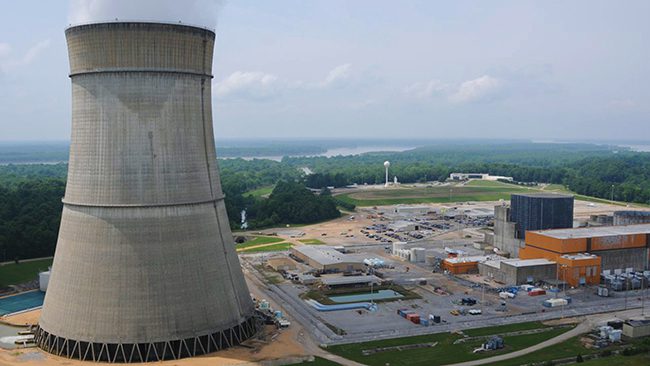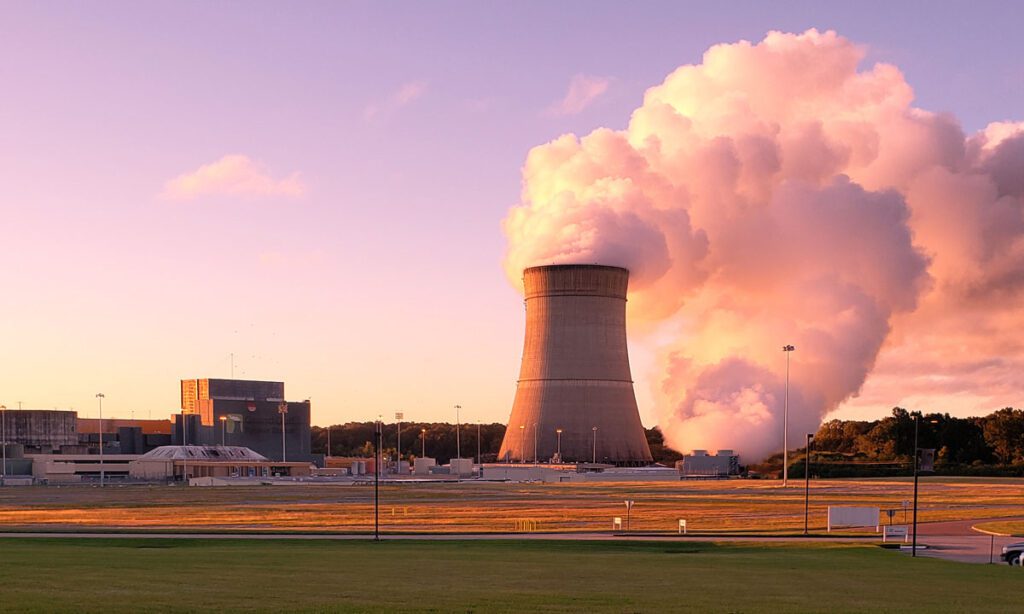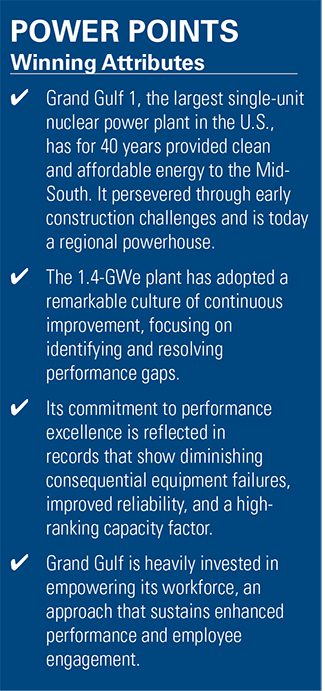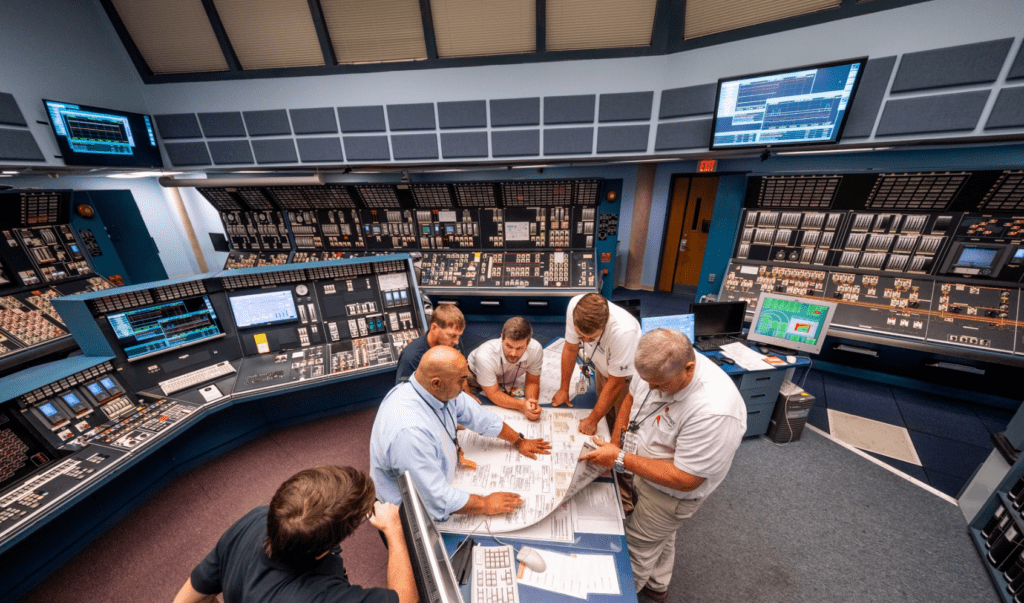America's Most Powerful Nuclear Reactor Makes a Landmark Revival
 |
Entergy’s Grand Gulf 1—the largest single-unit nuclear power plant in the U.S.—has thrived for four decades by cultivating a culture of continuous improvement, achieving record-breaking performance milestones, and empowering its workforce. The nuclear plant recently revived its value as a regional powerhouse through a renewed effort by visionary leadership focused on a commitment to excellence.
When using nuclear energy as a domestic energy source first became a possibility in 1954, Middle South utilities eagerly embraced the prospect. The behemoth company that grew out of an extraordinary ambition to electrify the Mid-South 110 years ago—and ultimately evolved into Entergy Corp.—formed the Southwest Atomic Energy Associates with other utilities in 1957 to explore the new energy source. Between 1969 and 1973, the consortium built and operated a test fast-breeder reactor near Fayetteville, Arkansas. The experimental success encouraged Middle South to contemplate tasking each of its four operating subsidiaries with financing and building a nuclear power plant.
Arkansas Power and Light (AP&L) took on Arkansas Nuclear One, a 1.8-GWe two-unit pressurized water reactor (PWR) nuclear power plant located outside Russellville, Arkansas, which was completed without incident and began operations between 1970 and 1980. But other projects that received a company green light—Mississippi Power and Light’s (MP&L’s) Grand Gulf 1 and 2 boiling water reactor (BWR) units, and Louisiana Power and Light’s Waterford 3 and 4 PWRs—were stricken by severe inflation, regulatory delays, and additional construction requirements precipitated by the Three Mile Island (TMI) nuclear incident.
By the late 1970s, grappling with staggering construction costs and the dawning reality that the system-wide demand in ensuing years would be lower than forecast, Middle South scrapped Waterford 4 and halted construction of Grand Gulf 2, even though the project was 66% complete.
Construction of Grand Gulf 1 in Port Gibson, Mississippi, continued, however, despite negative sentiment and significant cost increases that ran up its original price tag of $1.5 billion to greater than $3 billion (about $8.5 billion in 2023 dollars). When it became apparent that MP&L couldn’t underwrite the project on its own, Middle South in 1974 created a separate subsidiary, Middle South Energy (MSE), that would eventually own 90% of Grand Gulf, with a group of Mississippi cooperatives owning the balance.
But because MSE was a wholesale affiliate, the Federal Energy Regulatory Commission allocated Grand Gulf’s costs to Middle South’s subsidiaries, firing up an acrimonious financing dispute that precipitated a high-profile political controversy among the states it served. The legal wrangling about which of Middle South’s ratepayers would pay for the cost escalation continued for years, even after the 1,100-MWe project began commercial operations on July 1, 1985.
In 1988, the U.S. Supreme Court stepped in and reversed a Mississippi high court ruling, effectively approving MP&L’s rate hike while setting a precedent that bars states and local governments from interfering with interstate commerce. In 1989, Middle South sought to repair fractures and quell the crisis within its system by absorbing $900 million it invested in Grand Gulf Unit 2 under an initiative called “Project Olive Branch.” More remarkably, the crisis served as a visionary overhaul, and later that year, Middle South rebranded under a new name—Entergy. Today, the multi-billion-dollar energy giant forms a bedrock along the Gulf Coast.
While these events played out publicly, Grand Gulf’s champions stayed on course, banking heavily on public confidence, intent on a mission to furnish Mississippi with a long-term supply of emission-free power. “We were probably 60% through with construction when TMI happened,” recalled Randy Hutchinson, a retired Entergy Nuclear executive who worked through plant construction and startup, and was site vice president for several years.
“We’d done so much to get to that point. I think people understood that we were all in this together, and it was a team effort. Each of us had a job to do, and if we all did our job right, we would be successful.” The project “also had strong leadership from [MP&L President] Don Lutken and [Vice President] Norris Stampley,” Hutchinson added. “They were visionaries who knew what needed to be done. I give them a lot of credit because many of their peers in the industry abandoned their projects—but they never wavered.”

A Decades-Long Legacy
For nearly 40 years now, Grand Gulf has grown into a regional powerhouse, providing “safe, clean, carbon-free, affordable energy that supplies almost a fifth of Mississippi’s electricity while serving as one of the largest non-carbon-emitting power plants in the world,” Entergy told POWER. “In other words, the qualities that made Grand Gulf a sound investment in the 1970s are the same ones that continue providing benefits for customers, communities, and the environment today.”
But the power plant is, in many respects, a vastly different installation than when it first came online. Today, Grand Gulf is 90% owned by Entergy subsidiary System Energy Resources Inc. (SERI) and 10% by Cooperative Energy. Operated by Entergy Operations, the nuclear plant provides energy to only five customers: Entergy Arkansas, Entergy Louisiana, Entergy Mississippi, Entergy New Orleans and Cooperative Energy.
While the plant’s GE BWR 6 reactor with a Mark III containment was initially licensed in 1984 to produce 3,833 MWth, Entergy in 2012 implemented a 13% uprate to 4,408 MWth. The major upgrade boosted Grand Gulf’s capacity to 1,443 MWe, making the unit “the largest single-unit nuclear power plant in the country and the fifth largest in the world,” Entergy noted. In 2016, the Nuclear Regulatory Commission (NRC) validated the plant’s performance record by granting a 20-year license extension, allowing Grand Gulf to operate through 2044.
And, according to Brad Kapellas, Grand Gulf’s site vice president, the plant has continued to set performance records. In 2021, it set an all-time record of 95% capacity factor and all-time records for both gross generation and net generation in megawatt-hours. In 2022, Grand Gulf achieved the highest status in the NRC’s overall performance matrix. “Thus far in 2023, we’re operating in the 98th percentile for capacity factor,” he noted.

A Concerted Quest for Stellar Performance
Grand Gulf’s remarkable performance stems from a strategic approach highly deserving of this Top Plant award. In February 2020, during a refueling and maintenance outage, Entergy set out to implement more than $200 million in upgrades designed to improve plant performance, the most comprehensive of which was a $160 million project to replace and upgrade the existing electro-hydraulic turbine control system. The upgrade was necessary to replace an existing system whose equipment was obsolete, resulting in unplanned shutdowns. While the project was complex, it was made more cumbersome by the COVID-19 pandemic and lasted 93 days. However, after Grand Gulf’s return to service, the plant experienced numerous scrams directly related to unvalidated vendor assumptions of some equipment installed as part of the turbine controls upgrade, such as vibrational effects on the main turbine high-pressure control valve actuator assembly.
“Since 2020, we have resolved those issues, but it did take us some time to redesign and replace those actuators,” Kapellas said. But, pivotally, “during that period, we partnered with both our corporate nuclear leaders and industry peers to really work on plant reliability issues and establish a continuous improvement culture at the site,” he said.
A vital facet of the performance improvement strategy involved developing site-tailored work plans in continuous 100-day blocks, which allowed teams to assess, identify, prioritize, and succinctly tackle primary performance gaps. The “100-day” approach, developed with international industry collaboration, ensured work plans were manageable and continuous but also flexible. The program was measured with focused performance metrics and integrated a “check and adjust” effort that weighed an action’s effectiveness and results achieved, Kapellas said. At the same time, the site adopted a “fix it forever” mantra to ensure the issues wouldn’t occur again.
 |
But as significantly, to ensure the plan remained sustainable, the approach was heavily invested in empowering Grand Gulf’s 800-plus nuclear professionals from its outset. The plan engaged all employees, from corporate leaders to senior leaders, and cascaded through the front-line supervisors. That helped station leaders develop the workforce and build the proficiency to sustain performance gains.
“It proved a very productive approach,” Kapellas said. Grand Gulf remained at full power during the extreme heat of summer 2023. And the performance trend continues to improve, he noted. “As an example, in 2021, we had 14 consequential equipment failures. In 2022, we cut that to seven. And thus far in 2023, we’ve had one,” he added. Overall, the effort has “resulted in improved plant reliability, a better capacity factor, and really improved work-life balance for our employees, which are some of the most important stakeholders in what we do.”

While the plan was unique to Grand Gulf, Kapellas noted that the organizational emphasis on embracing and engaging employees is an Entergy Nuclear value. “Not all organizations are built that way, and there are arguments for and against [operating] at a high level with a very autocratic command and a strict way of doing business,” he said. “I believe this way is much more beneficial for everybody involved, and we get better results because of it.”
In its quest to become an industry leader, Grand Gulf may “still have room for growth and challenges like any power plant,” Kapellas added. “But this team handles it. We’ve invested just an incredible amount of energy into this talented workforce, we’ve set very high standards based on comparative industry data, and we support them to develop strategies and actions with that long-term view in mind,” he said.
—Sonal Patel is a POWER senior associate editor (@sonalcpatel, @POWERmagazine).